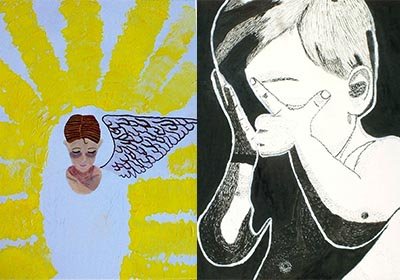eNewsletter - April 2018
Behavioral Health Partners
A Somatic Approach to Healing
By: Melissa Hedlund Nelson, LCPC, ATR-BC, SEP, CADC
“Trauma is not what happens to us, but what we hold inside in the absence of an empathetic witness.”
― Peter A. Levine
Following a traumatic car accident where he was struck by a car and rushed to the emergency room, Peter Levine, PhD, developed a body-oriented psychotherapy called Somatic Experiencing (Levine, 1997). Levine proposed that there are two things that need to be present following a trauma to ensure post-traumatic stress disorder (PTSD) does not develop, the individual that suffered the trauma must be able to move and have the presence of a calm individual in connection to them.
After Levine was struck by the car, a calm and kind woman rushed to him and stayed with him while awaiting the ambulance. Levine was in great pain, bleeding, and could not move his head or neck. Levine locked eyes with the woman, who returned a kind and calm gaze that let Levine know he was going to be okay. Additionally, when the ambulance arrived, Levine requested that he not be completely strapped to the gurney. The paramedics complied and left a little wiggle room for Levine to move. His body then involuntarily moved on the gurney which he recognizes as his body releasing trapped traumatic shock from the impact of the accident. The kindness of the stranger and the permission for his body to move is Levine credited with preventing him from developing PTSD.
The human being is a very complex animal. Most animals in the wild endure traumas on a daily basis but do not develop PTSD. For instance, an antelope grazing on grass can become immediate prey for a hungry cheetah but outruns the cheetah and does not have a trauma response.
When a human is confronted with a potentially traumatic or traumatic event, the body has three options, to fight, flight, or freeze. If the body goes into freeze mode, it is thought that the trauma can become trapped in the body. Somatic Experiencing is a body-oriented psychotherapy used to re-mediate trauma that has been trapped in the body.
Somatic Experiencing employs a repeating pendulation of movement from areas of higher activation to areas of lower activation in the body. This repeating movement allows for the stuckness in the nervous system to be released, which can return the body to homeostasis.
It is of importance to note that all animals, including humans, have been designed so their nervous systems are able to reach equilibrium. No matter what the trauma or stressor may be, or the degree of dysregulation that occurs in the nervous system, healing is possible.
The goal of Somatic Experiencing is to bring resolution and transformation for the individual affected by the trauma. It establishes and re-establishes defensive responses that the individual may not have been able to use during the traumatic event and establishes an orienting response to the present moment. There is also an uncoupling of fear from immobility, a discharge of traumatic shock from the nervous system, a connection to the felt sense, a tracking of sensations in the body, a titration of symptoms, creative self-regulation, containment, resources, and empowerment in the process (Levine, 1997; Gendlin, 1981).
Levine (1997) developed a 3 year training program for mental health professionals, medical and alternative medicine professionals, and bodyworkers, to become Somatic Experiencing Practitioners (SEPs). The program consists of 216 contact hours of training, 12 hours of personal sessions, and 18 credit hours of case consultations.
It is a robust program that prepares clinicians for navigating the most severe cases of PTSD. Somatic Experiencing takes trauma healing a step further than other healing modalities because it includes the body, where trauma is housed. As PTSD and traumatic responses are becoming more commonplace in today’s society, we need healing approaches that are holistic and include all elements of the self. To learn more about Somatic Experiencing, visit traumahealing.org.
References
- Gendlin, E.T. (1981). Focusing. New York, NY: Bantam.
- Levine, P. (1997). Waking the tiger: Healing Trauma. Berkeley, CA: North Atlantic.
Melissa Hedlund Nelson, LCPC, ATR-BC, SEP, CADC
Melissa is Program Supervisor of the Linden Oaks St. Charles Outpatient Center. She is a Licensed Clinical Professional Counselor, Board-Certified Registered Art Therapist, Somatic Experiencing Practitioner, and Certified Alcohol and Drug Counselor. She is a doctoral candidate in the Ph.D. in Expressive Therapies program at Lesley University and has a Master of Arts in Counseling Psychology: Art Therapy from the Adler School of Professional Psychology. Her clinical approach involves integrating Mindfulness Based Stress Reduction and Somatic Experiencing© with art therapy and counseling psychology. She has experience working with diverse populations, diagnoses, and treatment environments. Her expertise involves working with adolescents and women affected by PTSD, anxiety, depression, panic disorder, substance abuse, and those seeking wellness.
 |
 |
| Melissa Hedlund Nelson |
Some of Melissa's Artwork |